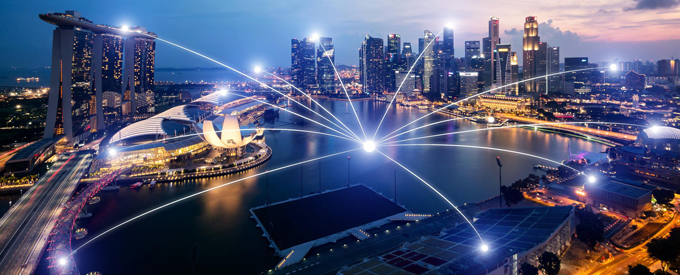2021-07-05
Building Foundations for Smart Cities of the Future
The evolution of smart cities has a key role to play in the struggle to make our way of life sustainable. From easing the global energy transition, to encouraging sustainable investment practices, smart cities are becoming the focal point for driving our global transition to a low-carbon future.
Cities account for about 75 per cent of global primary energy use and are by far the biggest producers of greenhouse gas (GHG) emissions at 70 per cent. While they only represent a minor contribution in terms of actual renewable energy production (through rooftop solar panels on homes and offices, etc.) they still have a vital role to play in the global energy transition.
A recently published IRENA report highlights the importance of cities as target setters, planners and regulators of renewable energy consumption. Given that they are the main source of demand and are also generally the owners of municipal infrastructure, cities need to be smarter in the way they design, build and operate the infrastructure in ways that encourage greater efficiency and sustainability.
Through its varied list of case studies from cities around the world, the report demonstrates how city authorities can work with national government institutions, private businesses and city’s residents to cut needless energy consumption/waste while boosting sustainability. These examples range from e-mobility initiatives in Costa Rica, to the installation of wind-powered heating systems in Zhangjiakou, China. Across all cases, the report emphasises the need for smart cities to strive for proactive local resident, community group and business engagement at every opportunity, bringing all interested parties into a programme of works designed to clean up the powering of their city.
Optimising Waste Disposal
While energy production and consumption are perhaps the most crucial target measures for a low-carbon future, waste management is another core focus for smart cities. By optimising the collection and disposal of waste, cities can reduce and eventually eliminate the significant levels of GHG emissions produced from burning rubbish or dumping it in landfill sites.
One recent example is the newly launched waste digitalisation and collection improvement initiative in Bratislava, Slovakia. City authorities have teamed up with technology company Sensoneo for a large-scale deployment of thousands of advanced sensors across the city’s waste management assets. The sensors will be attached to thousands of public waste containers across the city, as well as in the city’s fleet of waste collection vehicles. This will digitalise the waste collection process, automatically verifying pickups with the central administration system, while optimising pickup routes for the trucks.
The project includes digitalisation of 85,000 containers and installation of 1,753 Sensoneo sensors to monitor all containers for glass waste and underground bins across the city. Also, 92 Sensoneo WatchDog devices were deployed on all waste collection vehicles to automatically digitalise the waste collection process and verify pick-ups while dynamic waste collection was powered by Sensoneo’s Route Optimisation. The testing of prototypes was facilitated by the introduction of “pay-as-you-sort” models and recognising fill-levels of containers during pick-up.
Glass waste is particularly troublesome due to its irregular filling cycle, and Sensoneo says its real-time sensors offer invaluable time-savings by identifying when collection is required, thereby eliminating unnecessary pick-ups, while ensuring that bins will not sit overfilled.
This is a blueprint for other would-be smart cities to emulate. Not only does a data-driven, sensor-driven approach offer greater efficiency in how, when and where collections are made, it also provides the city with a much clearer overview of its waste management flows.
Self-sustaining Mechanism
2020 was a landmark year for sustainable finance and 2021 is positioned for more of the same.
City-level green banks are becoming a more integral part of this growing trend of sustainable finance investment worldwide. A green bank can be a public, semi-public, or not-for-profit institution offering financial products focusing specifically on climate mitigation projects, such as renewable energy and energy efficiency programmes. At the same time, they are using their resources to fund private sector smart city technologies, with the intention of making green funding a self-sustaining mechanism.
A recent example of this is the announcement that the Asian Development Bank (ADB) will be making a joint investment with the Green Climate Fund (GCF) in a smart and energy efficient city project (SEECP) in the Vietnamese Mekong Delta city of Can Tho. Between them, they will invest over US$67 million to develop smart city infrastructure.
In the Middle East, another significant partnership was announced recently between the Abu Dhabi Investment Office and Enterprise Singapore (ESG). They aim to create a platform for private companies to submit their own solutions to Abu Dhabi’s current challenges, thereby accelerating its smart city aspirations. Companies whose solutions are chosen and approved by the Abu Dhabi Investment Office will then be eligible for funding.
It’s hardly surprising that smart city development plans are becoming so embedded in the wider global struggle to lift urban populations out of their traditionally wasteful inefficiencies through the creation of sustainable practices and infrastructure. What is surprising is the speed with which this trend is growing.
While it’s true to say that bold statements about smart cities are easy to make, what we’re now seeing is a move beyond the rhetoric, as tangible smart city improvements and initiatives take place in cities of all sizes and development levels across the world.


No Comments